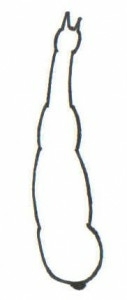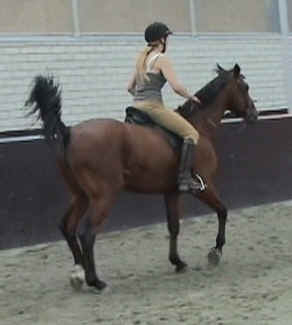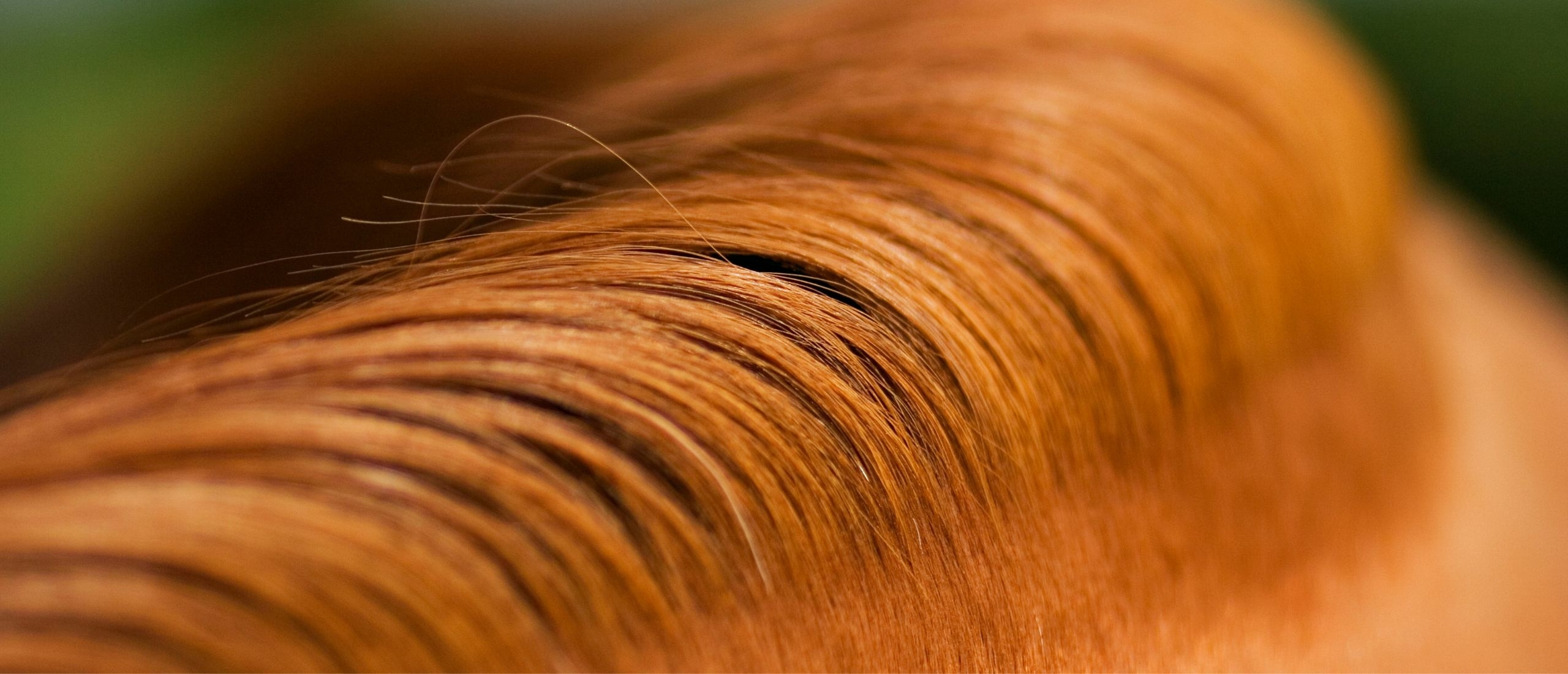
Lateral bending
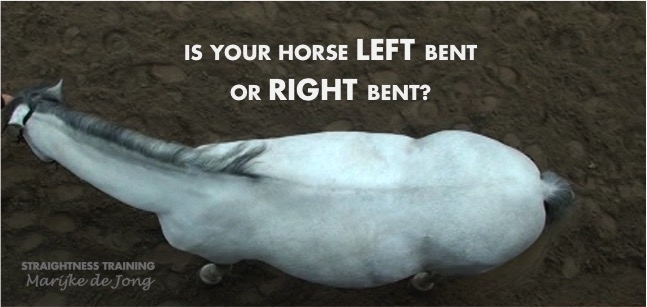
It’s an interesting fact that almost every horse bends naturally more easily to one side than to the other.
We call this the lateral bending of the horse.
But before we continue, be aware that there is a semantic difference between the lateral bend in the ‘spine’ and the lateral bend in the ‘body’.
If you want to read more about the lateral bend in the spine, click here:
But in this article, we talk about the lateral bend in the body.
The lateral bending of the body is a result of the natural movement of the spine, the muscles, and the use of the front and hind legs.
That means:
The body is bent from neck to tail, and is naturally bent to the left or to the right.
However, some horses have a continuous ‘S’-curve in their body.
But to keep it simple, let’s stick to the right and left bent horse for now.
Both the right bent and the left bent horse have a:
- concave, hollow side with short, stiff and strong muscles.
- convex, stretched side with long, supple, weak and less developed muscles.
RIght bend | Concave side |
Left bend |
At the end of this article, I will give you a checklist so you can figure out your horse’s lateral bend.
But first, let’s discuss the:
Symptoms of a left bent horse
A left bent horse will easily bend to the left and not as easy to the right.
Therefore, a very clear symptom of a left bent horse is that it will walk easily to the left and not as easy to the right in the arena.
|
|
|
When you ride this horse, it can feel as if the horse holds on to the bit on the right side and does not want to accept the bit on the left side.
This is because of the long right side and the shorter left side of the horse.
But there are more things you may notice on a left bent horse:
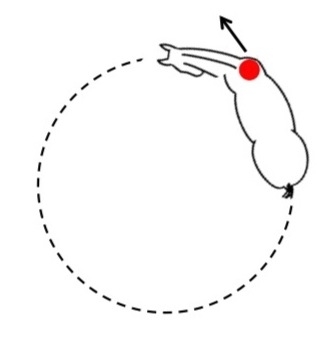
^ While riding a circle to the left, the left bent horse bends easier, and can tend to over-bend to the left.
This can make it fall out through the outside shoulder.

^On a circle to the right a left bent horse will prefer to fall inwards rather than bend its body.
It will try to keep the left bending and falls in on the inside shoulder; making the circle smaller.
The rider can then slide to the right and get crooked in her own body. Also, the stirrup on the right will hang lower.
We generally think that the cause is in the saddle, but you see that very often, it’s in the crookedness of the horse.
So adding more padding to the right side of the saddle, or shortening the stirrup on the right side, is not a solution here. We need to realize that it only fights the symptom.
The right bent horse has the opposite specifics and symptoms.
Knowing this, we must train ourselves to recognize the symptoms and acknowledge that our horse is not perfectly straight. Plus, Straightness Training is a valuable solution to bring our horse in balance.
Of course, the rider should also work on his own asymmetry and alignment of spine and pelvis.
But before we continue about Straightness Training, let’s address this often asked question about the lateral bending:
Are there more left bent or right bent horses?
It is interesting to see that there are different ‘beliefs’ on this subject.
According to the old masters such as Antoine de Pluvinel, François Robichon de La Guérinière and Gustav Steinbrecht and a few modern-day specialists, there are more left bent horses. According to some other trainers, there are more right bent horses.
Let’s see what riding masters have to say about the lateral bend of the horse:
Antoine de Pluvinel (1552 – 1620)
Pluvinel was the first of the French riding masters. He wrote L’Instruction du Roy l’exercice de monter à cheval (‘Instruction of the King in the art of riding’) and was tutor to King Louis XIII.
Pluvinel already noticed that horses bend easier to one side than to the other.
He wrote: “In general I work more on the right lead than on the left, like most of the horses has taught me. I always start on the right lead as most horses tend to go left.”
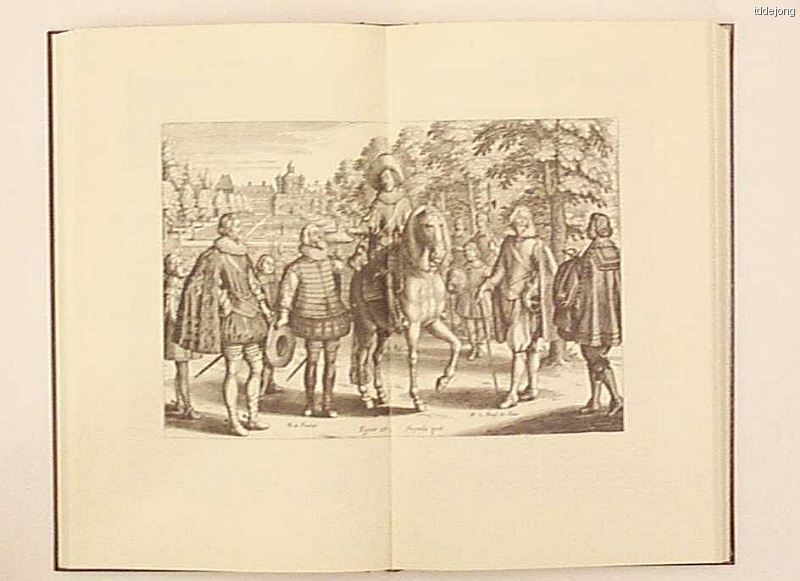
In Pluvinel’s book, King Louis XIII asks Pluvinel: “Why do you start on the right rein and not on the left, as it is a lot harder?”
Pluvinel’s answer is: “Several people looked for the cause at the unborn foal that in the womb bents completely to the left. Other said that horses at rest prefer to lie on the right side. However, I am not concerned with such arcane philosophies, because it arises purely out of habit: Everything happens to the left of the horse: tying, saddling, brushing, feeding, handling etc. And if a man leads the horse on the left, he prefers also to pull the head to the left.”
The King: “Its clear and understandable that for these reasons the horses are start on the right circle, the most difficult circle”.
François Robichon de La Guérinière (1688-1751)

La Guérinière was a French riding master. He is one of the most influential riders on the art of riding.
His famous book L’École de Cavalerie (‘The School of Horsemanship’) states about the lateral bend:
“Almost all horses find it easier to bend to the left.”
La Guérinière is credited for the invention of the shoulder-in on the straight line.
It’s interesting that especially the shoulder-in to the right (picture) is THE remedy for the naturally left bent horse.
Gustav Steinbrecht (1808 – 1885)
Steinbrecht writes in his famous Gymnasium des Pferdes about the lateral bend:
“It is a generally known fact that green horses have more difficulties on one side than on the other and that most horses initially have these difficulties on the right rein.
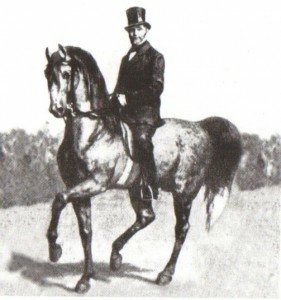
To discover the actual reason for this phenomenon is more the task of a researcher in natural sciences than of the practical horse trainer. It doesn’t matter to the horse trainer whether it is related to the fetus lying in the womb or because the groom approached him mostly on the left. In both cases, he can do nothing about it.
I want to mention this phenomenon only to warn against the mistake which often arises: the predominant working of one side while neglecting the other. It is indeed advisable to bend the stiff side more frequently by practicing the appropriate exercises a greater number of times.
Remember the old masters were accustomed beginning all exercises on the right hand, to then change to the left rein and ending after another change back to the right rein so that the bends to the right were always practiced twice as much.”
So here you can see that Pluvinel, La Guérinière, and Steinbrecht were convinced that most horses are left bent. But some more recent riding masters didn’t agree to that:
Wilhelm Museler (1887 – 1952)
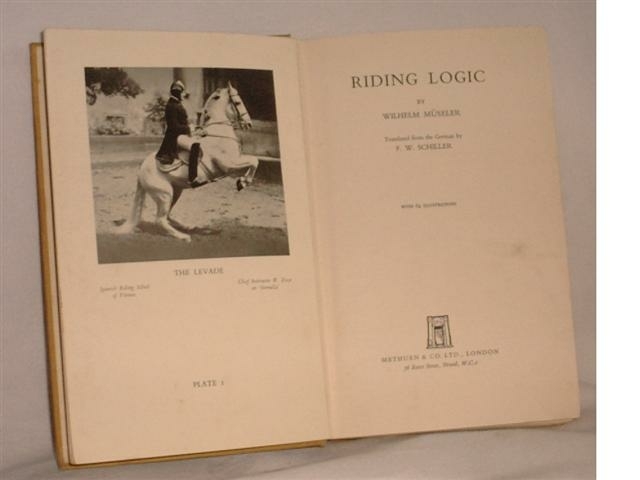
Museler was a well-known rider and competed in dressage and showjumping on a high level.
In his book Riding Logic, Museler mentions that all horses are naturally crooked.
He wrote: “People say this is related to the location of the unborn animal in the womb”.
Unlike the old masters, he believed that there are more right bent horses: “Most horses – like dogs – are crooked from ‘right’ back to ‘left’ front. The hindquarters will fall to the right.”
Üdo Burger (1914 – 1985)
Burger was one of Germany’s most esteemed veterinary surgeons and accomplished horseman.
In his book Vollendete Reitkunst (‘The way to perfect horsemanship’) he wrote about the lateral bend:
“A naturally straight horse does not exist. All horses are congenitally ‘crooked’, in the sense that their spine is more concave on one side than the other. This curvature is sometimes believed to be due to the position of the fetus in the womb, but there is no evidence to support the theory. Uneven development of both sides of the body is usual with human beings also.”
And have you heard of the ‘circling instinct’? Burger writes about this interesting point of view:
“All humans and animals show a tendency to walk in circles if they are blindfolded or deprived of points of orientation as in the dark of the night, in thick fog or in a dense forest. Walking in a perfectly straight direction necessitates constant correction of deviation with the help of the eyes.
The circling instinct is very noticeable in young children and young animals, and in the early stages of life it is no handicap because it always leads the infant back to his starting point whenever he becomes disorientated in his first exploration of the world.”
Then, instead of only left bent or right bent, horses can also have both; causing a bit of an ‘S-shape’. Burger writes about the S-shape in his book:
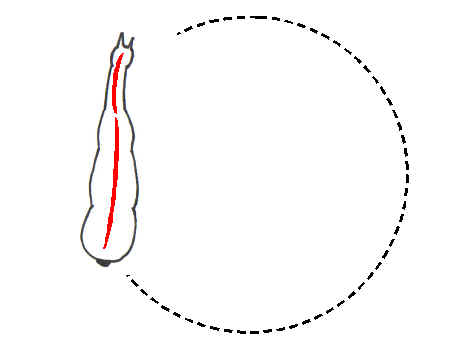
“Some reputedly incorrigible horses, that one rider after another has vainly tried to manage will have learned to twist themselves in a perpetual ‘S’ shape which has enabled them to evade all controls that their riders could think of. Although they willingly turn their head and neck right when the rider pulls on the right rein, in doing so they turn their hindquarters the other way.”
Dr. Reiner Klimke (1936 – 1999)

Dr. Reiner Klimke was a German equestrian, who won six gold and two bronze medals in dressage at the Summer Olympics — a record for equestrian events. He appeared in six Olympic Games from 1960 to 1988 (excluding 1980).
In his book Basic training of the young riding horse, Klimke states, like Museler, that there are more right bent horses than left bent.
So there are clearly different ‘opinions’ about this, and we still don’t know what is the truth:
Are there more left bent horses, like the old masters wrote? Or should we go with the more modern riding masters, are there more right bent horses?
Conclusion
Throughout the centuries, riding masters and riders have been dealing with the phenomenon of natural asymmetry and many also wrote about the lateral bend.
It is striking to realize that, besides many similar ideas and convictions, there are some very different perspectives, ideas, and beliefs that affected the training of horses.
Some trainers claim that there are more left-bended horses, others claim there are more right-bended horses.
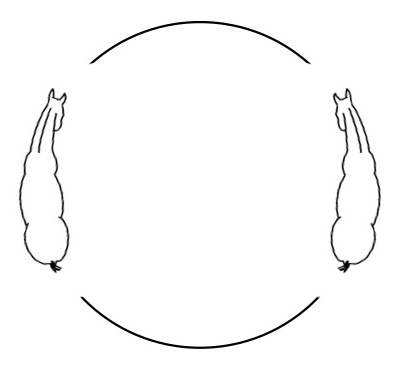
Scientifically, there has been no proof so far whether there are more right-bended or left-bended horses.
Therefore, it is important that we examine each horse as an individual and are willing to think outside the box.
Every horse should receive tailor-made training to be able to develop symmetrically:
The horse’s body needs to be able to bend equally to the left and to the right. And this requires a proper use of the skeleton and muscles in the body and legs.
You see, knowing the true cause of natural asymmetry does not really matter, but it is important to realize that lateral asymmetry is a fact that we cannot ignore and we will need to work with it.
We must be able to recognize the symptoms and acknowledge that our horse is not equal to both sides.
So, what about your horse?
Is he left or right bent?
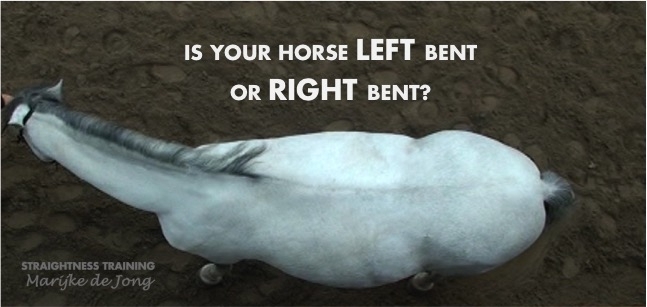
Whatever his lateral bending is, Straightness Training is a valuable solution to bring your horse in balance. It is designed to support you in making your horse supple to both sides.
How does this work? Well, let us take you on a fun learning journey with the free 4 part Mini Mastery Course!

